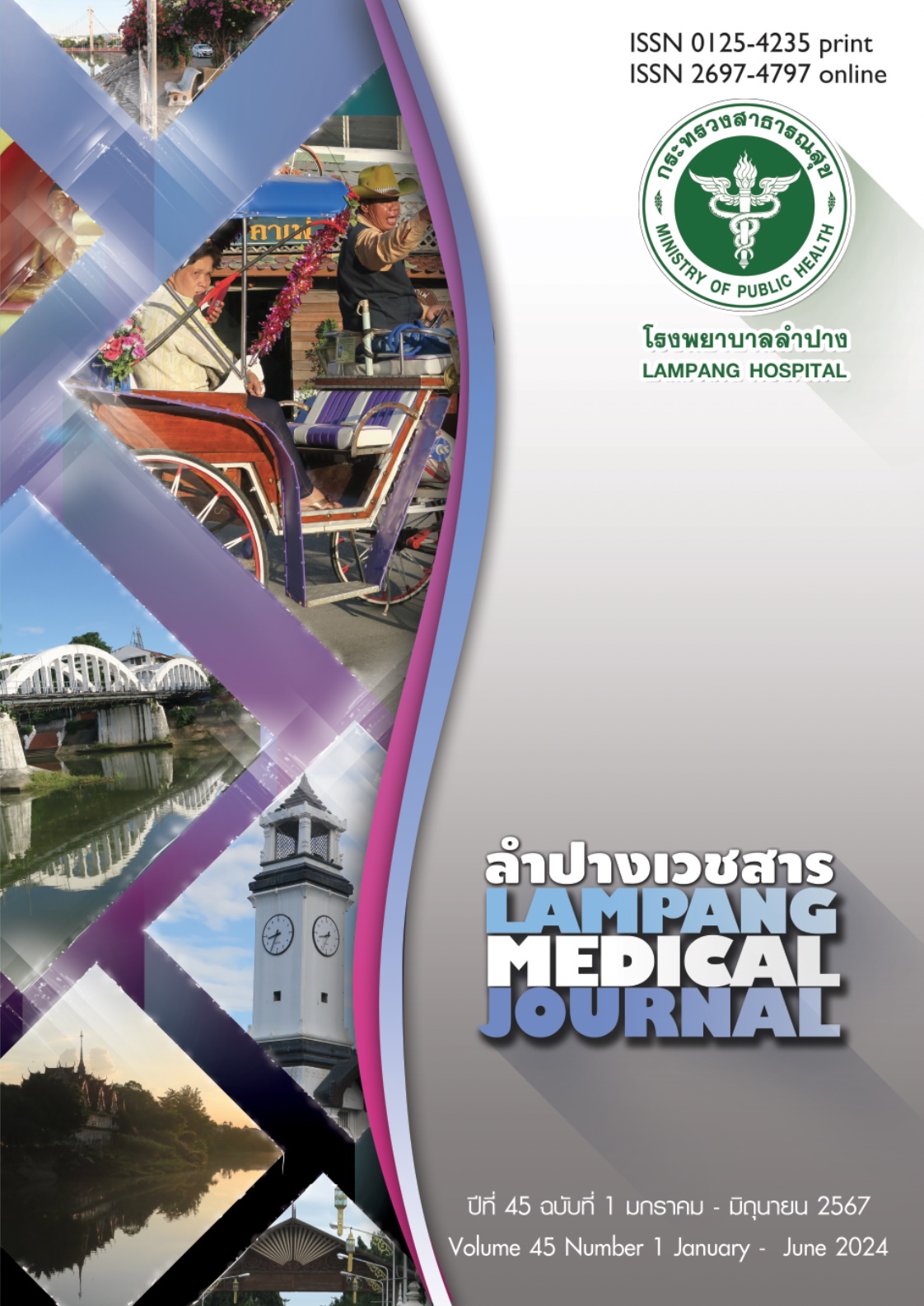Results of Developing a Liver Fluke Participatory-Prevention Model in Wang Ta Mua Subdistrict, Mueang District, Nakhon Phanom Province
Main Article Content
Abstract
Background: Liver fluke infection is a major cause of cholangiocarcinoma and a health problem in the northeastern region of Thailand. In Mueang District, the prevalence of liver fluke infection ranks among the top three highest districts in Nakhon Phanom province.
Objective: To study the outcomes of a developed model for liver fluke prevention through community participation in Wang Ta Mua Subdistrict, Mueang District, Nakhon Phanom Province.
Material and methods: This action research study was conducted with 61 participants, including village health volunteers, public health officers, teachers, monks, a villager representative, a village headman, a subdistrict headman, and members of the Subdistrict Administrative Organization, as well as 33 villagers who had concurrent liver fluke infections. The study consisted of ten operating steps: 1) problem analysis; 2) preparation of action plans; 3) educational activities; 4) disease prevention campaign activities; 5) creating a cooperation network; 6) monitoring infected villagers; 7) conducting a papaya salad cooking and market survey to ensure it was free from raw fermented fish; 8) setting community preventive measures; 9) monitoring, supervising, and evaluating the activities; and 10) exchanging and sharing knowledge. Data were collected using questionnaires, interviews, and observations and were analyzed using descriptive statistics, paired t-tests, and content analysis.
Results: After finishing the model, the target group had significantly higher levels of knowledge, attitudes, behaviors, and participation in liver fluke prevention (p<0.001). The success factors might be explained by the connection between network partners and the unity of people in the community, leading to the participation and mutual acceptance of those involved in all steps of development.
Conclusion: The development of a liver fluke participatory-prevention model in Wang Ta Mua Subdistrict could significantly increase the levels of knowledge, attitudes, behaviors, and participation in disease prevention. The community could create a participatory plan to address the problem using a more systematic operating model.
Article Details

This work is licensed under a Creative Commons Attribution-NonCommercial-NoDerivatives 4.0 International License.
บทความที่ส่งมาลงพิมพ์ต้องไม่เคยพิมพ์หรือกำลังได้รับการพิจารณาตีพิมพ์ในวารสารอื่น เนื้อหาในบทความต้องเป็นผลงานของผู้นิพนธ์เอง ไม่ได้ลอกเลียนหรือตัดทอนจากบทความอื่น โดยไม่ได้รับอนุญาตหรือไม่ได้อ้างอิงอย่างเหมาะสม การแก้ไขหรือให้ข้อมูลเพิ่มเติมแก่กองบรรณาธิการ จะต้องเสร็จสิ้นเป็นที่เรียบร้อยก่อนจะได้รับพิจารณาตีพิมพ์ และบทความที่ตีพิมพ์แล้วเป็นสมบัติ ของลำปางเวชสาร
References
สำนักบริหารการสาธารณสุข สำนักงานปลัดกระทรวงสาธารณสุข, มหาวิทยาลัยขอนแก่น. ยุทธศาสตร์ลดพยาธิใบไม้ตับ กำจัดโรคมะเร็งท่อน้ำดีวาระคนอีสาน. นนทบุรี:สำนักงานปลัดกระทรวงสาธารณสุข; 2559.
กรมควบคุมโรค กระทรวงสาธารณสุข. แนวทางการดำเนินงานป้องกันควบคุมโรคและภัยสุขภาพสำหรับพื้นที่ ประจำปีงบประมาณ 2563 ภายใต้แผนพัฒนาด้านการป้องกันควบคุมโรคและภัยสุขภาพของประเทศ ระยะ 20 ปี (พ.ศ. 2561-2580) ระยะ 5 ปี (พ.ศ.2561-2565). นนทบุรี: กรมควบคุมโรค; 2563.
บรรจบ ศรีภา. ละว้าโมเดล: โครงการควบคุมโรคพยาธิใบไม้ตับแบบบูรณาการวิถีนิเวศสุขภาพ. จุลสารศูนย์ประสานงานโรคพยาธิใบไม้ตับและ มะเร็งท่อน้ำดี ภาคตะวันออกเฉียงเหนือ 2559;1(2):9-11.
วีระพล วิเศษสังข์, รติกร ชาติชนะยืนยง, ชูศักดิ์ นิธิเกตุกุล. ศึกษาโปรแกรมการปรับเปลี่ยนพฤติกรรมโดยแกนนำสุขภาพประจำครอบครัวต่อการลดการเกิดโรคพยาธิใบไม้ตับในกลุ่ม วัยแรงงาน ตำบลขะยูง อำเภออุทุมพรพิสัย จังหวัดศรีสะเกษ. วารสารสำนักงานป้องกันควบคุมโรคที่ 10 2560;24(3):61-74.
กิตติศักดิ์ ประครองใจ.การพัฒนารูปแบบการป้องกันโรคพยาธิใบไม้ตับแบบมีส่วนร่วม ตำบลพรสำราญ อำเภอคูเมือง จังหวัดบุรีรัมย์. วารสารวิชาการสาธารณสุขชุมชน 2562;7(4):87-100.
สำนักงานสาธารณสุขจังหวัดนครพนม. รายงาน Primary prevention (คัดกรองพยาธิใบไม้ตับด้วยการตรวจอุจจาระและปัสสาวะ) ปี 2559-2563. สำนักงานสาธารณสุข จังหวัดนครพนม; 2563.
Kemmis S, Mc Taggart R. The action research planner. 3rd ed. Geelong, Victoria: Deakin University Press; 1988.
วราพร สุดบุญมา. การมีส่วนร่วมของชุมชนในการป้องกันโรคพยาธิใบไม้ตับ. วารสารการพยาบาลและการดูแลสุขภาพ 2564;39(3):81-90.
บวรพิพัฒน์ กระแสเสน, จุฬาภรณ์ โสตะ. การพัฒนารูปแบบการป้องกันโรคพยาธิใบไม้ตับในตำบลชานุมาน อำเภอชานุมาน จังหวัดอำนาจเจริญ. วารสารวิจัยสาธารณสุขศาสตร์ มหาวิทยาลัยขอนแก่น 2562;12(2):91-103.
สาริณี สีทะโน. การพัฒนารูปแบบการดำเนินงานป้องกันโรคพยาธิใบไม้ตับในชุมชนบ้านโพนยานาง ตำบลนาใหญ่ อำเภอสุวรรณภูมิ จังหวัดร้อยเอ็ด. วารสารบัณฑิตวิทยาลัยมหาวิทยาลัยราชภัฏสุรินทร์ 2559:10(1):62-72.


